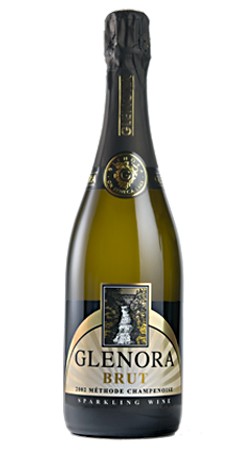To see the conversation thread and comments from the participants and winemakers, you can view that here.
@JamieGall1930 got the conversation going by asking, "Who doesn't love a little bit of bubbly especially around the holidays?" @thewinegetter agreed, "True, popping sparklers is always great. I was tempted to saber one or two, but it's too cold outside." Somebody always has to get out the sword!
Glenora Wine Cellars 2005 Brut Méthode Champenoise $30
Glenora winemaker Steve DiFrancesco and vineyard manager Chris King combine as co-workers to create the impressive line of wines from the Seneca Lake winery. The grapes - 52% Chardonnay and 48% Pinot Noir - were grown during the warm 2005 vintage. A moderate residual sugar of 1.2% makes for a clean, crisp balance and creaminess while the 12% abv should be a level that's easy to handle for anyone. The wine got a long aging period, so the semi-dry bubbly shows some great toasty flavors. This wine makes up only 171 cases of the 45,000 cases produced.
On Twitter, @amybcleary admitted, "I enjoyed all 3, but admit that this was the first bottle emptied." Since we were only a few minutes into the event, she clarified, “Note: I'm at work, so had to pre-drink earlier this week. I'm not that fast a drinker." That’s what I tell everyone, too, Amy! @thewinegetter had a favorable review, "Seriously impressed with the 2005 @Glenorawine! Nice tart apple, some raisin aromas, and tobacco."
I find the toastiness a little subdued at first, but the earth and fruit are stunning. After a few sips, the toasty, yeasty nature comes on a bit more. The mark of the aging is the creamy quality of this wine. My wife couldn't get over it - she calls it buttery - raving about the mouthfeel and the finish while pretending to cajole another glass from me. I'm always happy to share.
The bubbles pour up festive - small and tall - before dissipating into the rich, golden liquid quickly. The buttery, tangy Crucolo cheese is a perfect fit with this bubbly, and almost as nice with Castlevetrano olives.
Dr Konstantin Frank Chateau Frank Célèbre $21
The sparkling winemaker at Dr. Frank is Eric Bauman, and his cause célèbre is Riesling - fitting, since he's at the place that pioneered Riesling in New York state. It was a radical departure in the 1950s, when North American varieties were considered the only type that could be grown in the cold climate of New York. Fortunately, Dr. Frank didn't pay attention to the naysayers and started a wine revolution.
The comments were favorable on social media. @50StatesOfWine effused, "Love that @DrFrankWine is making a sparkling Riesling!" @thewinegetter tweeted, "Really nice Riesling Cremant from @DrFrankWine. Residual sugar a hit with my friends. I love the liquorice aromas. Reminds me of German Sekt."
Located on the Keuka Lake Wine trail, the winery takes grapes for this bubbly not only from the Keuka estate, but also from their estate vineyard on Seneca Lake. The 100% Riesling is made in the cremant style, méthode champenoise. This means it's made exactly the same way Champagne is made. Whole-cluster pressing results in what I call a nice greenness, while the 11% abv number makes for a very drinkable wine. The 3% residual sugar means it is definitely on the sweet side of the street.
The pale sparkler sure whips up a froth when poured. Medium-sized bubbles come up like a skyrocket before settling down after a bit. The yeasty aroma is plain from a distance, and the wine's nose is all Riesling. There is even a hint of petrol amidst the earthy fragrance of pears. On the palate, Riesling is apparent again. Great, sweet fruit is touched with a hint of earth and sourdough bread, and the finish really takes its time. Zippy acidity practically begs for food to be paired with it, while the sweetness says, "Make it spicy!"
Winemaker Christopher Stamp is the grandson of the farm's founders. He has 25 vintages as a winemaker under his belt. David Stamp - another grandson - oversees the grape growing in the family's 80 acres of vineyards on the west side of Seneca Lake. Alcohol is restrained - as usual in the Finger Lakes - at 12% abv. 210 cases were produced, and the wine retails for $30. It's 100% Pinot Noir."
Those gathered on the Twitter stream were impressed. @50StatesOfWine asked, "First sparkler a Catawba, then a Chardonnay, now a Pinot Noir - what will @LakewoodWines do next?!" @LocalVinacular commented, "the first 2 sparkling wines we'd have for sipping wines, but we like the @LakewoodWines Blanc de Noir to pair with food."
The golden hue is beautiful and inviting. There is earth and yeast on the nose, with the earthy side carrying more weight. Scents of apple, pear and a bit of apricot lay underneath the textural design. On the palate, the flavor of crisp green apples really shines, while the earth notes take a step back to let the fruit do its job. They do not shrink away entirely, however, so there is enough of the good Seneca Lake soil in the mix to provide a great counterpoint. The acidity is sterling and the wine feels quite full in the mouth. Paired with Crucolo cheese from northern Italy, nice; with our fruit and nut bread from La Brea Bakery, perfect.
Follow Randy Fuller on Twitter






